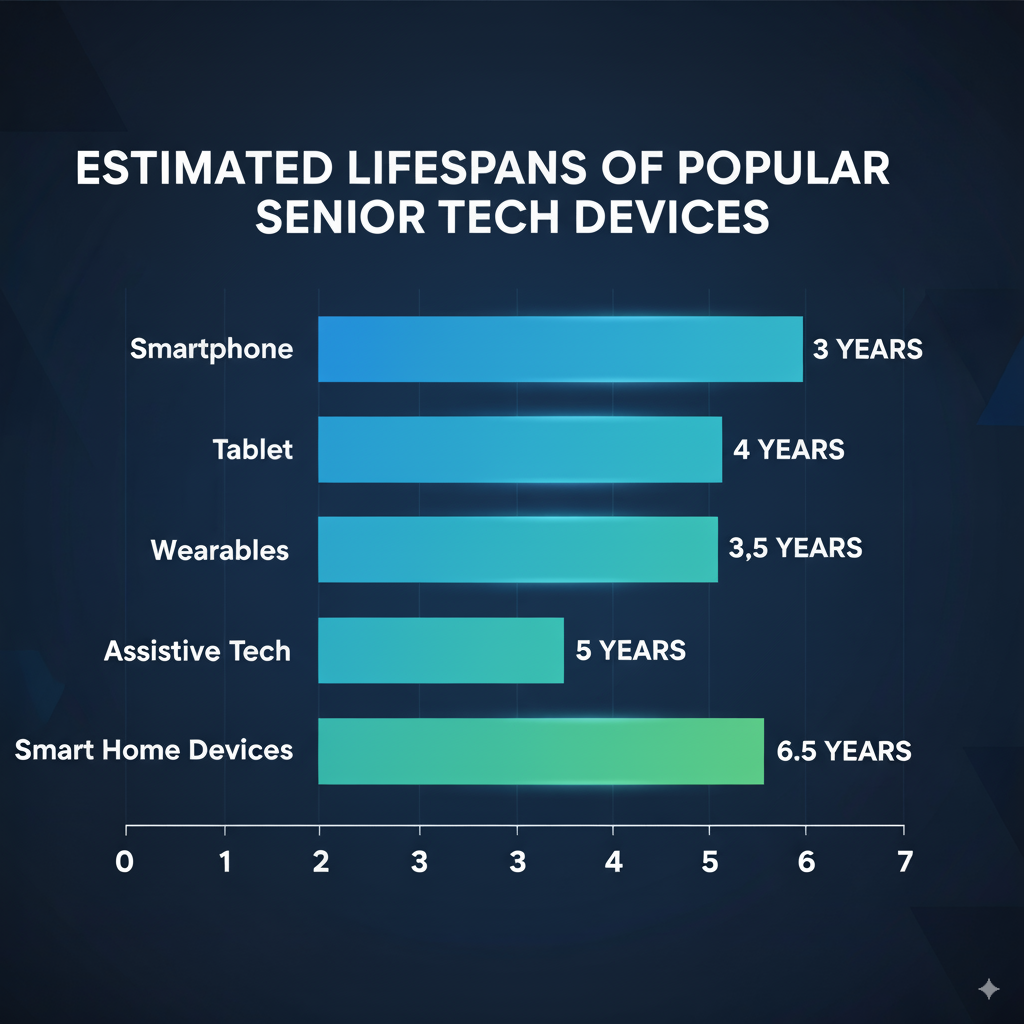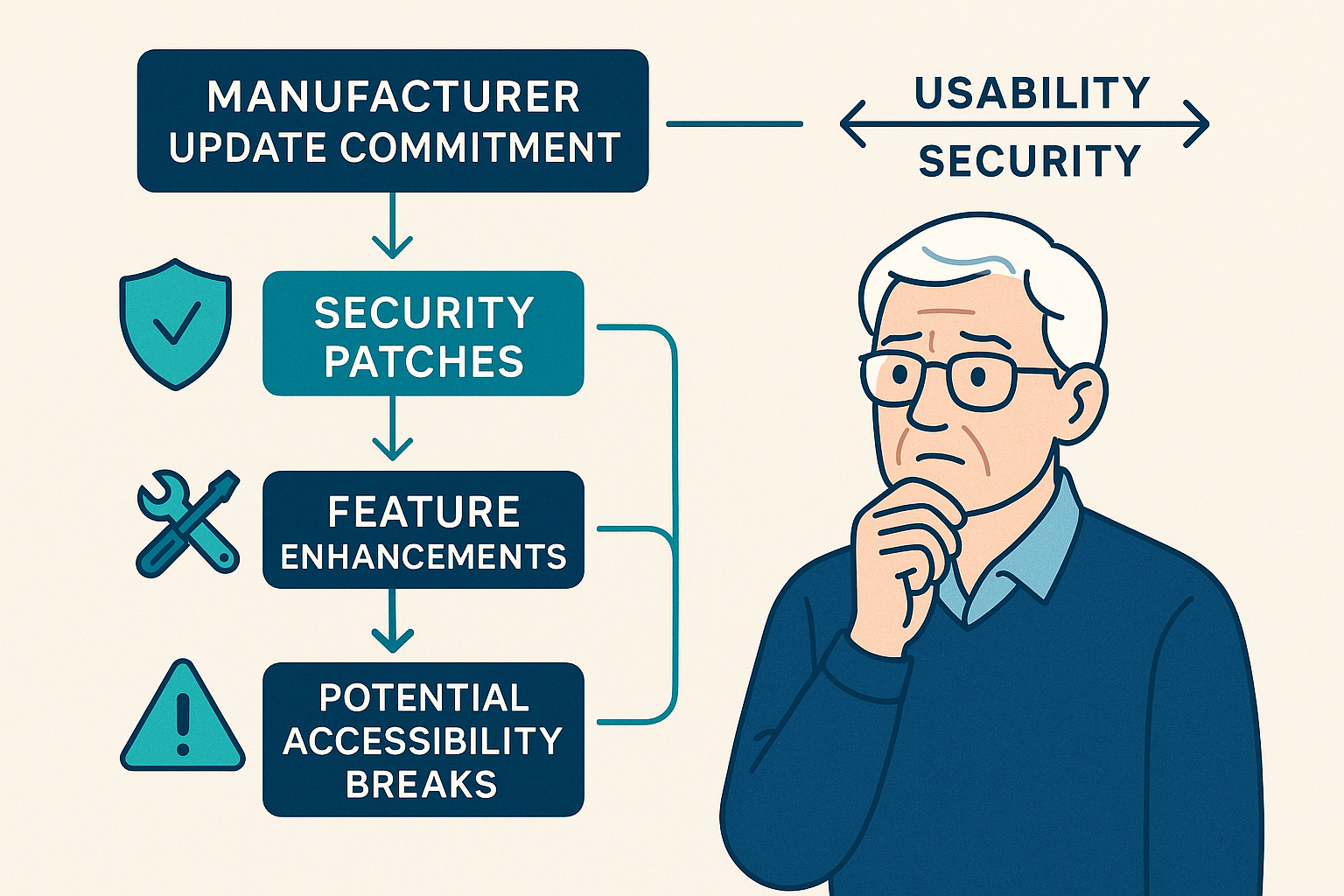
Newsletter Subscribe
Enter your email address below and subscribe to our newsletter

Back in the day, you bought a microwave and it ran faithfully for 20 years.
Today’s gadgets? By the time you’ve figured out how to change the font size, they’re already outdated.
Buying tech can feel like buying bananas—perfectly green in the store, brown and mushy by the time you get home. And unlike bananas, unfortunately tech doesn’t make good banana bread once it’s “overripe.”

For many of us, technology isn’t just about fun—it’s about staying independent and connected. A whopping 94% of seniors want to “age in place,” and technology is a huge part of making that dream a reality.
Sure, it’s easy to laugh about fast-aging gadgets, but underneath the humor is something serious: technology has become one of the biggest tools for seniors to stay independent and connected.
We rely on our devices for everything from health monitoring to keeping up with grandkids, so choosing wisely is more important than ever.
But how do you pick a gadget that won’t become a digital dinosaur faster than you can say “software update”?
How do you avoid those pesky tech troubles that pop up just when you’ve gotten comfortable?
This guide is your trusted roadmap to making smart, long-lasting technology investments. We’ll empower you to choose devices that stand the test of time, keep you secure, and adapt to your changing needs without breaking the bank. Let’s dive in!
Think of your technology like a trusty old car. Some models are built to last over a decade with proper care, while others might start sputtering after a few years.
The same goes for your smartphones, tablets, and smart home devices. Understanding a device’s typical lifespan is the first step in future-proofing your investment.
On average, a smartphone might give you a good 3-5 years, while a tabletA tablet is a lightweight, portable device with a touchscreen that you can use to browse the interne... More could last 4-6 years.
Smart home devices, like smart speakers or security cameras, often have a similar lifespan, sometimes even longer if they’re well-maintained.
Assistive technology, which is often specialized and crucial, might need replacement less frequently, but its longevity can depend heavily on manufacturer support and the availability of parts.
What makes one device last longer than another? It’s often a mix of build quality, the durability of its internal components, and the reputation of the brand.
Some manufacturers are known for making devices that are practically bulletproof, while others might use cheaper materials that wear out faster.
It’s a bit like choosing between a solid oak table and one made of particle board. One will be around for generations; the other might barely survive a few holidays.

Unfortunately, about 30% of electronic parts reach their “End-of-Life” without clear notification from manufacturers.
This “planned obsolescence” can be a real headache, forcing you to replace devices prematurely and adding unexpected costs, especially for specialized accessibility tech. So, looking into a brand’s history of product support and longevity is a smart move.
If device lifespan is the hardwareHardware refers to the physical components of a computer system or electronic device, as opposed to ... More story, software updates are the nagging reminders. They pop up uninvited, insist on attention at the worst possible moment, and won’t leave you alone until you deal with them.
Annoying? Absolutely.
But they also lock out online threats and occasionally surprise you with handy new features you didn’t know you needed.
However, the software update maze can be tricky, especially for seniors.
Sometimes, an update might completely change the way your device looks or works, making familiar tasks suddenly confusing. It’s like rearranging all the furniture in your house overnight; suddenly, finding the sugar can feel like a scavenger hunt!
Even worse, inconsistent or poorly communicated software updates can sometimes break critical accessibility features or introduce complex user interface changes, turning a helpful device into a frustrating puzzle.
To future-proof your tech, it’s vital to understand a manufacturer’s commitment to software support. Look for brands that promise a minimum number of years for operating systemAn operating system (OS) is software that manages computer hardware and provides a platform for runn... More and security updates.
This information isn’t always shouted from the rooftops, but it’s often available on their websites. Clear communication from the manufacturer about update changes, especially those impacting accessibility, is a huge plus.

When an update arrives, don’t just blindly hit “install.” Take a moment to see what’s included.
If you’re nervous, or if you rely on specific accessibility features, it might be wise to wait a few days and see if other users report any issues.
Sometimes, a little patience can save you a lot of head-scratching.
When it comes to buying technology, the “new car smell” of a brand-new device is certainly appealing.
But for many seniors, especially those on a fixed income, budget concerns are real. This often leads to the question: is buying refurbished tech a smart move or a risky gamble?
Choosing between new and refurbished devices is a critical decision for long-term value.
Refurbished devices are pre-owned items that have been inspected, repaired, and restored to working condition, often by the manufacturer or a certified reseller. They can save you a significant amount of money.
| Feature | New Tech | Refurbished Tech |
|---|---|---|
| Cost | Full Price | 20–70% Cheaper (Significant Cost Savings) |
| Environmental Impact | New Production (More Resources) | Reduced Waste (Environmentally Friendly) |
| Warranty | Standard, Longer Warranties | Shorter Warranties (Reputable sellers offer them) |
| Technology | Latest Features, Cutting-edge | Often Previous Generation (May lack latest features) |
| Battery Life | Optimal Battery Capacity | Potentially Slightly Reduced Battery Capacity |
Pros of Refurbished:
Cons of Refurbished:
Key Considerations for Seniors:
For simpler devices like tablets or smart speakers, refurbished can be an excellent, budget-friendly option.
For something you rely on heavily, like a smartphone or a specialized medical device, buying new might offer more peace of mind due to the longer warranty and latest features.
“Easy-to-use” is always at the top of the list for senior tech, and for good reason. But true future-proofing means looking beyond immediate simplicity to consider how a device will serve you tomorrow, next year, and beyond.
This is where those “hidden intents” of adaptability come into play.
Here are a few features to prioritize:
Even the most future-proof gadget is only as good as the support system behind it. Tech adoption is high among older adults, with 66% reporting that technology enriches their lives, but significant barriers like lack of tailored support still persist.
This means having access to help and learning resources is just as important as the device itself.
Ready to make a smart tech investment? Use this handy checklist to guide your decision-making process.
It’s designed to help you think through all the important elements we’ve discussed, ensuring you pick a device that will serve you well for years to come.

Most smartphones are designed to last 3-5 years, but with good care and regular software updates, some can go longer. It also depends on how demanding your usage is and if newer apps require more power.
Potentially, yes. If a device no longer receives software updates, especially security patches, it becomes more vulnerable to new online threats. This is a key reason why consistent software support is so important.
First, check the device’s manual or online support page. If that doesn’t work, contact the manufacturer’s customer support. For ongoing issues or learning, reach out to your “tech support circle” (family, friends), or look for local tech support services or community classes.
Often, yes. While a higher upfront cost can be a consideration, a device that lasts longer, receives ongoing updates, and adapts to your needs can save you money and frustration in the long run. It’s an investment in your independence and peace of mind.
Look for certified refurbished products, ideally from the original manufacturer or a well-known retailer. Always check for a warranty (at least 90 days) and a clear return policy. Read reviews about the seller’s refurbished products if possible.
Choosing new technology doesn’t have to feel like a high-stakes poker game where you’re always bluffing.
By understanding device lifespans, prioritizing smart software support, and weighing your options carefully, you can make confident choices that truly future-proof your digital life.
Remember, technology should work for you, not the other way around.
At Senior Tech Cafe, we believe that understanding your tech makes it more enjoyable. With this guide, you’re now equipped to make informed decisions that ensure your gadgets remain valuable, accessible, and supported for years to come.
So go forth, invest wisely, and enjoy the wonderful world of technology!